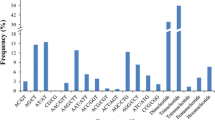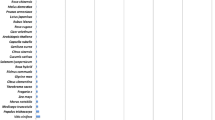Abstract
Sets of polymorphic expressed sequence tag–simple sequence repeat (EST-SSR) markers from the rubber tree (Hevea brasiliensis) have been published by many researchers, but none has been specifically developed to study latex and wood yield traits. In this study, a total 10,321 rubber tree EST sequences, generated from suppression subtractive hybridization-cDNA libraries of bark and latex of high- and low-yielding clones, were used as sources for SSR searching. A total of 432 EST-SSR loci were identified and it was possible to design primer pairs for a subset of 298 EST-SSRs. The highest proportion of EST-SSRs was represented by dinucleotide repeats (46.6 %), followed by trinucleotide repeats (44.3 %). Based on BLASTX analysis, 234 ESTs (80 %) showed similarity to genes in NCBI databases and could be divided into 120 putative proteins with known function and 114 unknown proteins. To enhance the resolution of an existing linkage map from previous work on a rubber tree RRIM600 × PB217 population, 69 EST-SSR markers from the above set were tested to be integrated into the reference genetic map. The enriched map of 18 linkage groups spanned 2054.2 cM in length, showed an average genetic distance of 4.3 cM between adjacent markers, and included 63 new EST-SSR markers. The enhanced map from this study provides a basis for comparative mapping using PCR-based markers and identification of expressed genes possibly affecting important traits of interest.



Similar content being viewed by others
Abbreviations
- DNRs:
-
Dinucleotide repeats
- EST:
-
Expressed sequence tag
- SSRs:
-
Simple sequence repeats
- TNRs:
-
Trinucleotide repeats
References
Aggarwal RK, Hendre PS, Varshney RK et al (2007) Identification, characterization and utilization of EST-derived genic microsatellite markers for genome analyses of coffee and related species. Theor Appl Genet 114:359–372
Altschul SF, Madden TL, Schäffer AA et al (1997) Gapped BLAST and PSI-BLAST: a new generation of protein database search programs. Nucleic Acids Res 25:3389–3402
Bindu RC, Nazeer MA, Saha T (2004) Identification of simple sequence repeats in rubber (Hevea brasiliensis). Curr Sci 87:807–811
Bozhko M, Riegel R, Schubert R et al (2003) A cyclophilin gene marker confirming geographical differentiation of Norway spruce populations and indicating viability response on excess soil-born salinity. Mol Ecol 2:3147–3155
Cardle L, Ramsay L, Milbourne D et al (2000) Computational and experimental characterization of physically clustered simple sequence repeats in plants. Genetics 156:847–854
Chen CX, Zhou P, Choi YA et al (2006) Mining and characterizing microsatellites from citrus ESTs. Theor Appl Genet 112:1248–1257
Cordeiro GM, Casu R, McIntyre CL et al (2001) Microsatellite markers from sugarcane (Saccharum spp.) ESTs cross transferable to erianthus and sorghum. Plant Sci 160:1115–1123
Cubry P, Pujade-Renaud V, Garcia D et al (2014) Development and characterization of a new set of 164 polymorphic EST-SSR markers for diversity and breeding studies in rubber tree (Hevea brasiliensis Mull. Arg.). Plant Breed 133:419–426
Doyle JJ, Doyle JL (1987) A rapid DNA isolation procedure for small quantities of fresh leaf tissue. Phytochem Bull 19:11–15
Ellis JR, Burke JM (2007) EST-SSRs as a resource for population genetic analyses. Heredity 99:125–132
Feng SP, Li WG, Huang HS et al (2009) Development, characterization and cross-species/genera transferability of EST-SSR markers for rubber tree (Hevea brasiliensis). Mol Breed 23:85–97
Gao LF, Tang J, Li H et al (2003) Analysis of microsatellites in major crops assessed by computational and experimental approaches. Mol Breed 113:163–185
Jung S, Albert A, Jesudurai C et al (2005) Frequency, type, distribution and annotation of simple sequence repeats in Rosaceae ESTs. Funct Integr Genomics 5:136–143
Kanjanawattanawong S, Tangphatsornruang S, Triwitayakorn K et al (2014) Characterization of rubber tree microRNA in phytohormone response using large genomic DNA libraries, promoter sequence and gene expression analysis. Mol Genet Genomics 289(5):921–933
Kujur A, Saxena MS, Bajaj D et al (2013) Integrated genomics and molecular breeding approaches for dissecting the complex quantitative traits in crop plants. J Biosci 38:971–987
Lekawipat N, Teerawatanasuk K, Rodier-Goud M et al (2003) Genetic diversity analysis of wild germplasm and cultivated clones of Hevea brasiliensis Muell. Arg. by using microsatellite markers. J Rubber Res 6:36–47
Lespinasse D, Rodier-Goud M, Grivet A et al (2000) S saturated genetic map of rubber tree (Hevea spp.) based on RFLP, AELP, microsatellite and isozyme markers. Theor Appl Genet 100:127–138
Li D, Deng Z, Qin B et al (2012) De novo assembly and characterization of bark transcriptome using Illumina sequencing and development of EST-SSR markers in rubber tree (Hevea brasiliensis Muell. Arg.). BMC Genomics 13:192
Mangpung Y, Kongsawadworakul P, Viboonjun U et al (2010) Identification and characterization of candidate genes related to latex yield in the inner bark tissues of rubber tree (Hevea brasiliensis). Thai J Bot 2(Special Issue):207–214
Parkinson J, Blaxter M (2009) Expressed sequence tags: an overview. In: Parkinson J (ed) Expressed sequence tags (ESTs): generation and analysis. Methods in molecular biology, vol 533. Humana Press, New York, pp 1–12
Polhamus L (1962) Rubber: botany, production, and utilization. World Crops Books, Leonard Hill Limited, London
Prapan K, Lekawipat N, Weber C et al (2006) Molecular genetic markers and rubber breeding in Thailand: 1-Genetic mapping of the family RRIM600 × PB217 by use of microsatellite markers. In: 2006 The 2nd Thai-French seminar rubber cooperation, Bangkok, Thailand, 1 September 2006, pp 1–10
Qureshi SN, Saha S, Kantety RV et al (2004) Molecular biology and physiology: EST-SSR: a new class of genetic markers in cotton. J Cotton Sci 8(2):112–123
Rahman AYA, Usharraj AO, Misra BB et al (2013) Draft genome sequence of the rubber tree Hevea brasiliensis. BMC Genomics 14:75
Rattanawong R, Prapan K, Lekawipat N et al (2008) QTLs detection for growth and initial latex production in rubber (Hevea brasiliensis). In: 2008 IRRDB international natural rubber conference and annual meetings, Kuala Lumpur, 13–14 October 2008. IRRDB, pp 1–28
Scholze C, Peterson A, Diettrich B et al (1999) Cyclophilin isoforms from Digitalis lanata Sequences and expression during embryogenesis and stress. J Plant Physiol 155:212–219
Thiel T, Michalek W, Varshney RK et al (2003) Exploiting EST database for the development and characterization of gen-derived SSR-markers in barley (Hordeum vulgare L.). Theor Appl Genet 106:411–422
Towaranonte B, Chuenwarin P, Kongsawadworakul P et al (2010) Identification and characterization of candidate genes related to latex yield in the laticifers of rubber tree (Hevea brasiliensis). Thai J Bot 2(Special Issue):199–206
Triwitayakorn K, Chatkulkawin P, Kanjanawattanawong S et al (2011) Transcriptome sequencing of Hevea brasiliensis for development of microsatellite markers and construction of a genetic linkage map. DNA Res 18:471–482
Van Ooijen JW (2006) JoinMap® 4, Software for the calculation of genetic linkage maps in experimental populations. Kyazma BV, Wageningen
Acknowledgments
This research was supported by Rubber Research Institute of Thailand (RRIT), Department of Agriculture, the Thailand Research Fund (TRF) Grant No. MRG5180088 with Faculty of Science, Mahidol University and a grant from Mahidol University, Thailand.
Author information
Authors and Affiliations
Corresponding author
Electronic supplementary material
Below is the link to the electronic supplementary material.
Rights and permissions
About this article
Cite this article
Nirapathpongporn, K., Kongsawadworakul, P., Viboonjun, U. et al. Development and mapping of functional expressed sequence tag-derived simple sequence repeat markers in a rubber tree RRIM600 × PB217 population. Mol Breeding 36, 39 (2016). https://doi.org/10.1007/s11032-016-0461-3
Received:
Accepted:
Published:
DOI: https://doi.org/10.1007/s11032-016-0461-3




